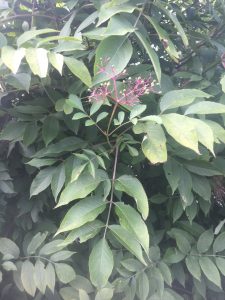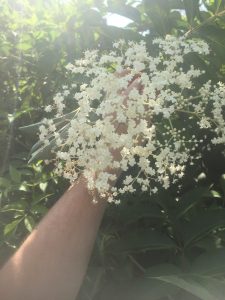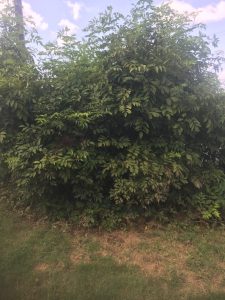(Sambucus nigra, Sambucus canadensis)

Description
Elderberry is a fast-growing perennial shrub that can grow 2 to 3 meters tall, sometimes in a single season if well pruned! It grows opposite compound leaves with 7 to 13 serrated leaflets. In the late spring to early summer the plant will fill up with clusters of white flower bunches. The individual flowers are flat and shallow and make excellent nectar source for bees and other beneficial insects. Bunches of flowers produces bunches of berries, starting out green and ripening in mid-summer to dark purple. If left unpruned, elderberries can form a virtually impenetrable wall of green.

Cultivation Tips
Elderberries are extremely durable once established after their first year and can be easily propagated from hardwood cuttings. In the late fall (before ground freezes) or early spring (just after ground thaws), prune branches from the plant and simply stick them into the ground. Branches can be cut as long as you like, but at a minimum should contain two pairs of growth buds; one that gets pushed underground to produce roots and one that stays above ground to produce shoots and leaves in the spring [70]. Cuttings can also be taken at any time throughout the winter and rooted indoors or in a greenhouse. Always use sharp, clean pruning shears when taking cuttings.
Elderberries can also be started from seeds. The easiest way to do this is to leave it to the birds, but if desired you can gently crush the berries and soak them in water for a day to remove the flesh and un-viable seeds (they will float). Then simply push the viable seeds into the ground about a centimeter in the location where you wish to grow the plant. Plant a few seeds as not all will germinate.
Pruning can be necessary to maintain ease of harvest and to produce maximum fruit. Some varieties, such as “Marge”, produce fruit on second year growth, so first-year branches should be left unpruned. Other varieties like “Ranch” produce fruit on their first-year growth and can be cut back to the ground during dormancy [70]. If a plant is growing too tall to harvest, it can be pruned during the growing season; this will encourage it to branch more laterally, leading to a bushier plant. If elderberry is intended for use in a hedgerow, windbreak, or living fence, no pruning is necessary.
Elderberry is not picky about soil type, and can handle periodic flooding and high water tables as well as periodic drought [70]. Many varieties require full sun for maximum fruitset, but certain varieties will fruit in the shade, and propagation stock can be obtained from elderberries even if no fruit is produced.
In the summer when the flower and ripe berry bunches are plentiful, cut the entire bunch off the plant and hang upside-down to dry for storage through the winter.
Uses
Elderberry flowers and fruit are highly medicinal. They have been used for centuries by indigenous peoples, and modern research has shown that elderberry contains high levels of anthocyanins and polyphenols which have immune-boosting, anti-oxidant, and anti-inflammatory activity [71-74]. Elderberry extracts have shown to be effective in treating influenza [71] (the flu) and common colds [72], as well as reduce HDL (bad) cholesterol [73] and suppress oxidative damage at a cellular level [74]. These anthocyanins and polyphenols can be extracted into an elderberry/elderflower tea or syrup. The indigenous people of Lenapehoking used elderberry flower tea as a tonic for newborns and to cure colic [109].
To make a tea, simply add 1 tbsp of dried elderberries per cup of water to a covered pot and bring to a boil, then reduce heat and simmer for 15 minutes. For a syrup, add 1 cup of sugar or honey and boil down. Elderberries can also be used in pastry filling. See our recipes page for more details on how to prepare elderberry.
Elderberry flowers are an excellent source of nectar for pollinators and other beneficial insects. They provide food for and make great shelter for a variety of birds, which help with seed dispersal and protect the garden from pest bugs.
Due to their prolific growth habits, elderberry plants can make an excellent addition to a hedgerow, windbreak, or living fence. Although they do tend to get eaten by deer, they grow so quickly that they can actually keep the deer from being able to get through.
